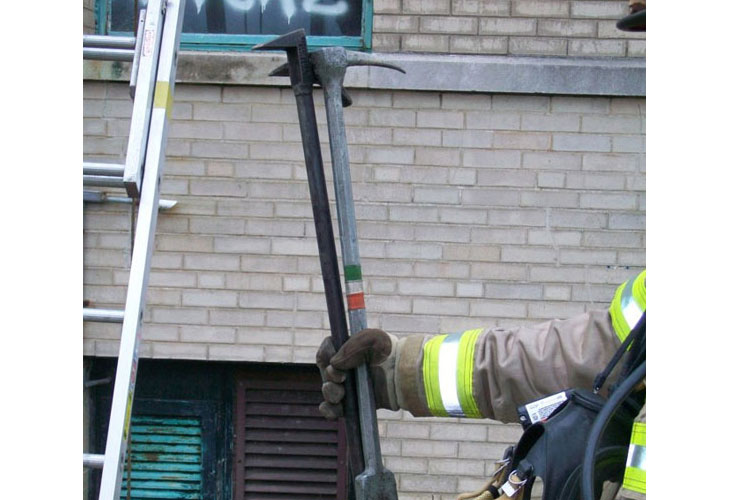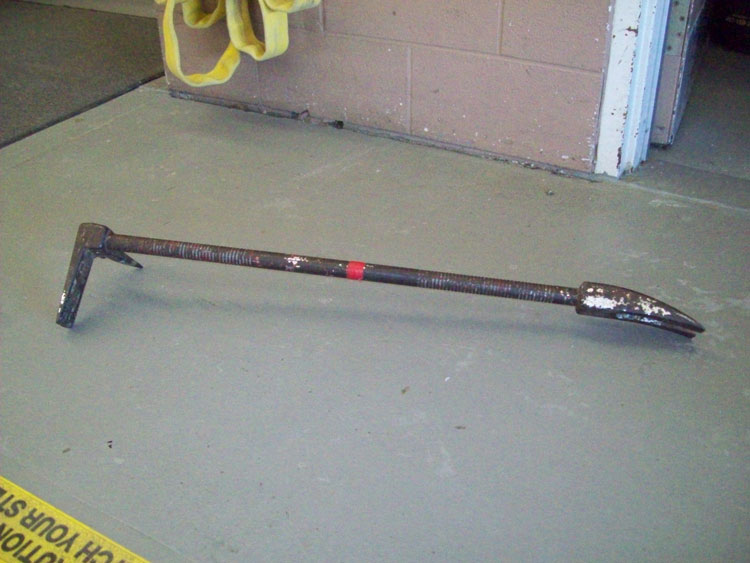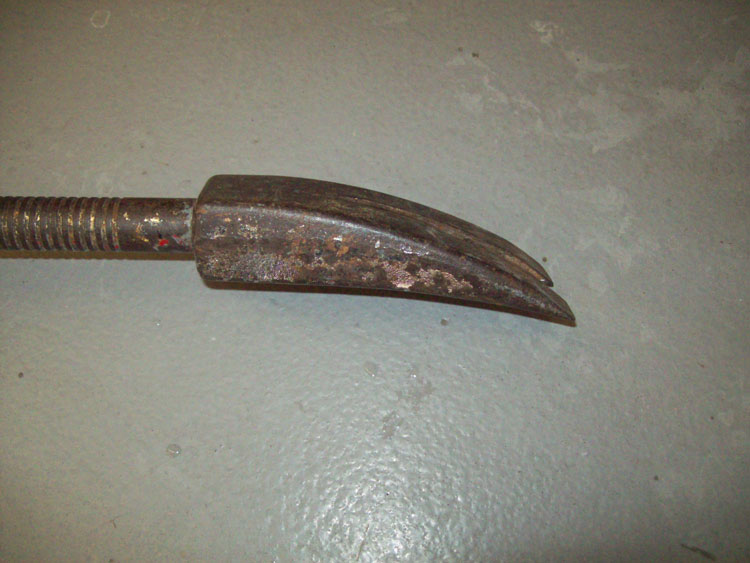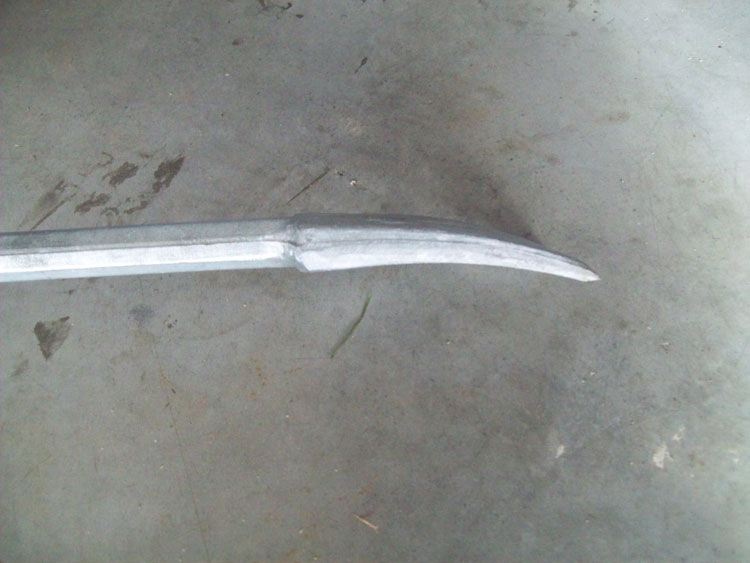

(1) The halligan bar and the roof hook, two favorite tools of the truck company firefighter.
By Mark van der Feyst
Firefighters have many tools that we carry with us on our apparatus or in our pockets. Our fascination with tools is a longstanding tradition that will never go away. Visit trade show vendors and you will find an assortment of tools on display. We have tools designed for every situation imaginable, and if there is not a tool designed yet for a certain situation, just wait and firefighters will develop one. Our tools provide us with the ability to complete the tasks that have been assigned to us; they are an extension of our hands.
In basic training, we are taught that each firefighter is to bring with them a hand tool of some sort. This is for two reasons. One is for personal survival and the other is for operational purposes. Sometimes the greatest challenge is choosing which tools to bring. It’s critical to select the right tool to bring with us to do the job.
RELATED: Clay Magee: The Ins and Outs of the Halligan: A Comparison | Mike Ciampo: Truck Company Tools Across the Country
Most of us will only bring one hand tool, as we have drilled this way often, but we all have two hands and are able to carry two tools. So why not carry two tools with us? If you are a truck company firefighter, you will know the value in having two tools with you when trying to complete the task. If there are two of you assigned to a task, then that means four hand tools at your disposal. Remember the saying of FDNY Lt. Michael Ciampo: “Two hands, two tools.”
With relation to truck company operations, we have a variety of tools that we have at our disposal. Below are 10 truck company functions:
- Rescue
- Ventilation
- Forcible entry
- Reconnaissance
- Laddering
- Overhaul
- Elevated master streams
- Salvage
- Utility control
- Rapid intervention
Knowing these functions will dictate our tool requirements. The tools we must select from for truck company operations are those that can be used for the majority of these 10 functions. The only function that will not require hand tools is elevated master streams. The basic set of tools for truck company operations are halligan bar, roof hook, pike pole, ax (both flathead and pick head), chain saws, and rotary saws.
Photo 1 shows the roof hook and the halligan bar, the latter of which is the most well-known tool in the fire service. This tool was invented/introduced by Hugh A. Halligan, a New York City firefighter. He introduced this tool primarily for forcible entry operations. It is the one tool that we as a fire service can benefit the most from. Law enforcement agencies are also benefiting from this tool when they are forcing open doors when serving warrants.
There are many halligan bars on the market today: the hooligan bar, the halligan bar, and the Pro-Bar. The hooligan bar is one of those other types of bars (photo 2). It is a bar that has two pins holding the fork end and the adz end to the shaft. The halligan bar has two welds holding the fork end and the adz end to the shaft. Hugh Halligan’s original design was a one piece of forged steel (photo 4), as in the case of the Pro-Bar. It is balanced when carried and offers the best advantages when using it for forcible entry operations.

(2) The hooligan bar has pins at both the top and bottom end holding the fork and adz end to the shaft.

(3) The fork end of the hooligan bar. Notice the thickness of the fork at the shaft end.
The forks are beveled such that they are on a slight angle to allow the best fit between the door frame and the door. They are also slimmer in design. The other types of bars have their forks at extreme angles and are thicker than the original design (photo 3), which offers very little advantage in forcible entry. The thicker the fork, the harder it will be to force open a door. The thinner the fork, the easier it will be to force the fork between the door frame and the door.

(4) The fork end of the Pro-Bar. The original design calls for a slimmer fork, allowing it to be versatile when forcing open a door. Notice the one piece of forged metal.
The halligan bar can also be used for search operations as an extension of our arm. It can be used for ventilation operations with clearing out windows and for self-extrication as an anchor point for firefighter survival. It is a very versatile tool with many uses, not of which are all listed here.
The roof hook is another favorite tool of the truck company firefighter. Emerging from the Fire Department of New York, this tool is designed for roof operations when trying to accomplish ventilation. These tools come in varying lengths, with the most common being five and six-foot lengths. As you can see in photo 1, the top of the tool has two angled hooks that are spaced apart from each other.
The very top hook has a sharp edge to it, allowing the user to penetrate through different surfaces both outside and inside of the structure. Once this penetration is accomplished, it can then be used to pull down or pry the material off of the surface. It also serves well for sounding the roof when stepping on it as well as advancing on the roof. At the bottom of the roof hook are different ends: a pry wedge, a fork, D-handle, ram knob, or a gas shut-off tool. The most popular choice is the pry wedge. This allows the user to pry open various items, such as scuttle hatches when trying to gain entry or ventilate.
The roof hook also serves well when conducting overhaul operations. The hooks themselves allow the firefighter to pull off wall moldings, trim, lath and plaster, tin ceilings, drywall, and door or window casings. By penetrating the wall surface or ceiling area, it is useful for inspecting by creating an inspection hole.
The attractiveness of the roof hook is that it is very light and it constructed out of one piece of metal. The original versions of the roof hook are constructed from aircraft steel, very lightweight with strong characteristics. Other versions are made from fiberglass and are not as strong as the aircraft steel models. When one is wearing structural firefighting gloves, its diameter is more user-friendly when compared to pike poles.
Many different fire departments will mount these two tools in different places on the apparatus. They can be mounted on the front bumper or on the side of the apparatus near the rear passenger door, up by the platform on an aerial device, or with the ground ladders.
One firefighter with these two tools in their possession can accomplish a multitude of tasks on the fireground. By having two tools in two hands, a firefighter, whether truck company or not, can be a valuable asset for the incident commander.
 Mark van der Feyst has been in the fire service since 1999 and is a full-time firefighter in Ontario, Canada. He is an international instructor teaching in Canada, the United States, and India, and at FDIC. He is a local level suppression instructor for the Pennsylvania State Fire Academy and an instructor for the Justice Institute of British Columbia. He is also the lead author of Residential Fire Rescue (Pennwell).
Mark van der Feyst has been in the fire service since 1999 and is a full-time firefighter in Ontario, Canada. He is an international instructor teaching in Canada, the United States, and India, and at FDIC. He is a local level suppression instructor for the Pennsylvania State Fire Academy and an instructor for the Justice Institute of British Columbia. He is also the lead author of Residential Fire Rescue (Pennwell).
MORE MARK VAN DER FEYST

